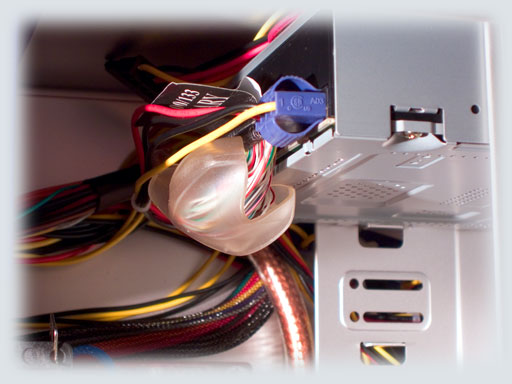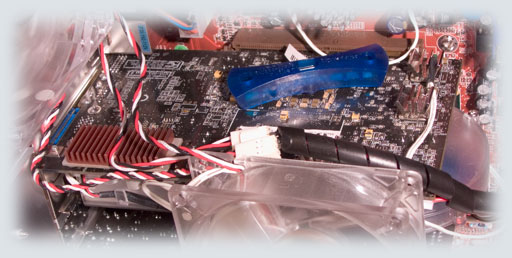Here are some numbers to chew on:
Mobile Athlon XP Barton core running at 2466Mz, driven by 2.00volts with an FSB setting of 205 (411 double-pumped)
ATi Radeon 9800 nonPro running at 403MHz core rate and 344MHz video memory (DDR688)
5983 in 3DMark03
4309 in PCMark04
This is the first time I've taken a Socket A platform to a score so close to my Socket478 PCMark04 record of 4968, set by Alpha Three back when the Radeon was in it.
Anyhow I'm sure an extremely small portion of the SPCR community here cares about this sort of thing, so I wanted to get that up and out of the way before moving on with this, so that all-out silence members won't be disappointed in what I've chosen to do here.
Actually let me state it out right: the prerogative (sic?) with Project Gamma is all-out gaming performance in a highly portable system with highly acceptable (by overclockers' standpoint) acoustics. I will say right here, right now, that Gamma Two EASILY outperforms Gamma One at a lower noise floor in terms of volume, and a much, much lower noise floor in terms of sound signature!!! I found the number one limiter in Gamma One was the mainboard; the FN41V3 simply isn't up to snuff when it comes to the level of overclock I sought to achieve, combined with the I.C.E. cooling system that just didn't perform nearly as well as I was hoping for, and an outboard AGP slot that limited my choice of VPU coolers, forcing me to settle for less performance and more noise!
Gamma Two is the solution.
Components:
System Enclosure: Antec Super LAN Boy
Case Mods: Front exhaust and rear exhaust comletely cut clean using snips and lined with chrome auto door trim and AcoustiFan AF120CT softmounted to rear exhaust
Power Supply Unit: New Model Fortron FSP300-60PN
Power Supply Mods: Stock Yate Loon fan replaced with Globe 120mm thermal controlled fan, hooked into PSU internal fan wiring through an inline resistor that was included with an AcoustiFan
Mainboard: ABIT AN7
Mainboard Mods: Stock northbridge cooler scrapped in favor of Swiftech MCX-159, with fan removed and five pins removed to fit the tight spacing (see images below)
Central Processing Unit: AMD Mobile Athlon XP 2400+ (Stock 1800MHz)
CPU Cooling: Thermalright SP-97 with Japan-made Panaflow M1B
Memory: Two pieces, Kingston HyperX PC4000, 512MB each (1GB total)
Graphics Adapter: Sapphire-built Radeon 9800 nonPro 128MB card
Graphics Card Mods: Arctic Cooling VGA Silencer Version 3 and TweakMonster BGA RAMsinks
Hard Disk Drive: Samsung SpinPoint SP1614N
Optical Drive: Silver NEC ND-2500A
Images and Descriptions (For broadband viewers and people who are interested, clicking the image in this thread will bring up a blow-up of the image in a new window for you):
I chose the Antec Super LAN Boy because of its super light weight, 120mm intake and exhaust, outstanding build quality, decent looks and very good price point. I also like Antec's grommeted hard drive trays, which would serve as a good interim solution until I figure out a form of suspension that can hold up to travelling, assuming I can come up with one.

The AN7 by ABIT proved to be an optimal solution for squeezing the most out of AMD's Mobile Barton core and proved far more capable than the poor example served by Shuttle's FN41V3 (the board included in the SN41G2V2 XPC). By raising the core voltage to 2.00, I am able to run the CPU at a solid 2466MHz, tested 100% stable with a 48hour straight Prime95 Torture Test marathon, at an FSB setting of 205 (205.5 as detected by CPU-Z).
By removing the plastic garnish in front of the factory-mounted 120mm Antec LED intake fan, I got access to the four screws holding the fan on, and simply abolished it. After that, I opened up the case and removed the six screws holding the front bezel on, leaving the front of the chassis exposed to my snips and I, which resulted in a decently open intake:
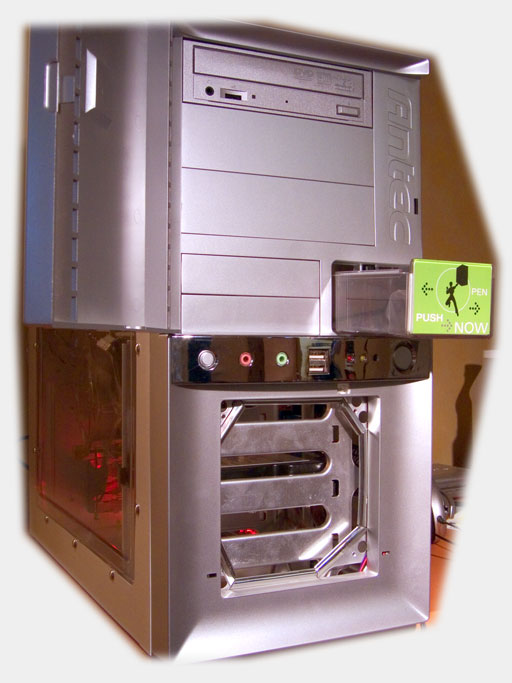
The snips, of course, left some rather raw edges, which I decided to simply line with chrome automotive door molding, since it jives well with the silver case.
The stock exhaust fan does not come mounted, but comes wrapped in mounting instructions inside of the case during shipment. I removed the included silicone mounts and utilized them on an AcoustiFan AF120CT out back:
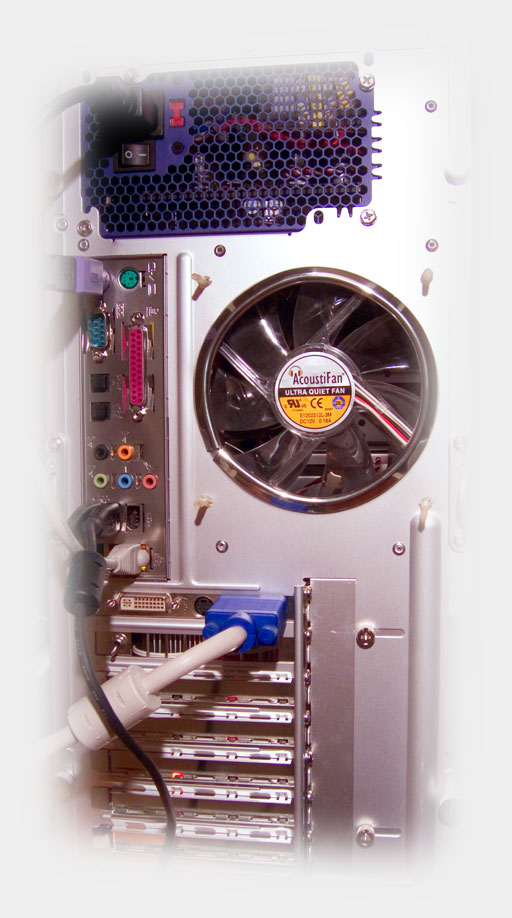
As you can see, I also lined the raw edges with chrome automotive door trim in order to protect tender hands.
As you see in the image above, the PSU is blue:

But I did not paint it; in fact, the latest Fortrons come from the factory this way! The fan also comes with a new, clear Yate Loon fan of the same model as the older, black model. In the image above, however, the fan is black; this is because I have swapped the stock fan for a Globe 120mm thermal control fan.
In fact they also come presleeved:
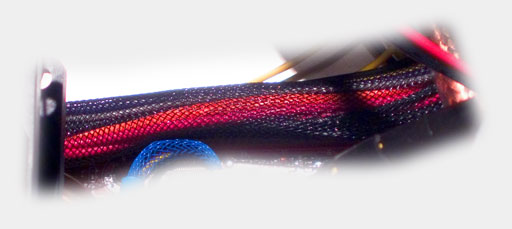
and with new, easy to grip blue plastic Molex connectors:

Overall, I am definitely loving the latest Fortrons. They've taken a great product at this price point and truly made it the best PSU for this price, bar none!
The CPU is cooled by a Thermalright SP-97 all-copper, heatpiped heatsink that is mounted through the board for secureness:
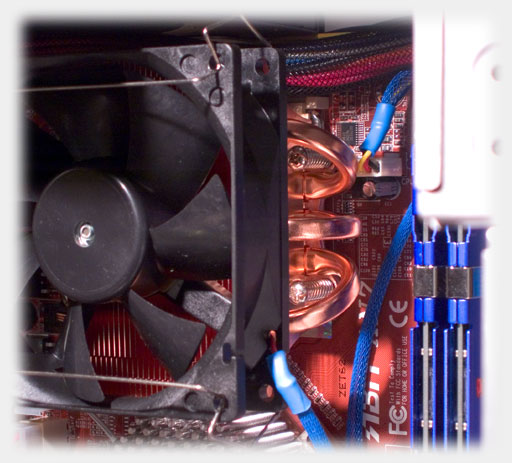
Mounted on top of it using clips is a Panaflow M1B, attached to and thermally speed-regulated by the mainboard. The fan was custom-sleeved for $1.50 extra by Jab-Tech, and I lucked out as the M1B I received is made in Japan. I was also pleasantly surprised to find that it supports speed monitoring. If you don't get a chance to click on any other images, do at least click this one; I think it's one of the best photos I've yet taken!
The stock northbridge proved a rather poor performer (ABIT's uGuru was detecting its temperature to be hitting over 50C!!!), and it was noisy to boot, so I swapped the stock ASUS cooler back into Alpha Three, since it made no difference, and moved its Swiftech MCX-159 over to Gamma Two:

From this angle it is clear just how tight the fitting is, being that ABIT chose to place the northbridge literally right next to the CPU; in fact, I had to actually break off five of the helicoid pins from the nearside of the MCX-159 in order for the two sinks to be at peace with one another. This is another good image to click on and get a close-up of.
The video card has been heavily modified in order to extract the highest overclock possible on air cooling.
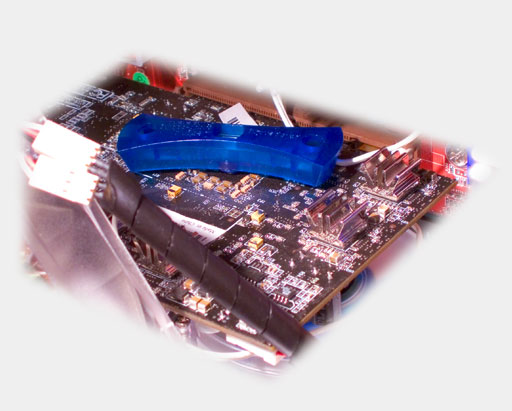
This image shows a couple things. You can clearly see the blue plastic shroud that Arctic Cooling has around the metal tension clip used to mount the VGA Silencer, and as you can also see, I have the TweakMonster BGA RAMsinks mounted so as to take best advantage of the flow of air coming off of the AF92CT that has been mounted to a Zalman fan bracket for blowing on the VRAMsinks as well as the northbridge cooler.
One of the best things about Arctic Cooling's VGA Silencer, and a distinct advantage (among others) that it has over Zalman's ZM80C-HP is that it leaves room enough for RAMsinks on the back, since it does not have much back there besides the clip, but it also leaves plenty of room underneath it on the front side for RAMsinks as well:

From this view, a few things are notable; there is more than enough room for the frontside RAMsinks to fit under the VGA Silencer, as barely visible through the blades of AcoustiFan, which, as shown here, blows right across the card to the sinks. Right above the very same fan blade, just barely visible is a round, green thermal diode; this diode is blocked from view by the wire wrap of the power cable in the image above this one, and is wedged right into the RAMsink; it belongs to the AF92CT blowing over the memory. Finally, you can see how I was able to cleverly hide the floppy power cable going into the card by running it inside the wire wrap I used for the fan power cables, whose 3-pin connectors are visible in the image above this one. One connector for each AcoustiFan, the AF120CT exhaust and the AF92CT video ram and northbridge fan.
Finally, here is the outside-in view with the clear side panel on:
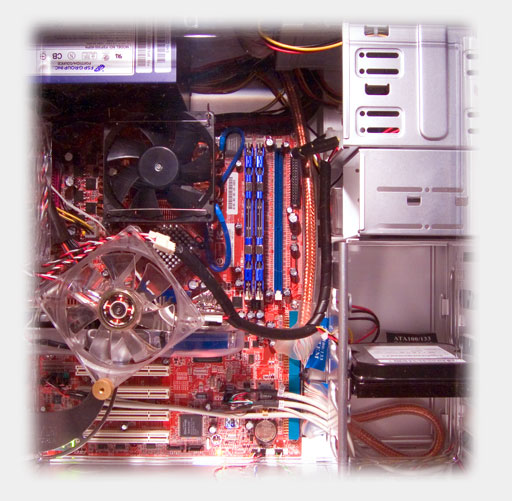
This wraps up images.
Final comments (for now):
I know that the modifications to this system are very minor and not particularly special, but I am restricted in my focus points, being maximum overclockability and also maximum portability. I will continue to focus on improving this system's acoustics, as it is the loudest of my three rigs, and needs the most work. Also, I think of it as the greatest challenge and well worth it.
As it is, this machine is already far exceeding my expectations, and completely crushes Gamma One on every front except for overall size. Weight is not as good, but it's still very, very light, particularly for its size, and the included straps make transporation easy as pie, as I have already utilized twice now. This case, actually, is truly incredibly light; the side panels, in fact, are so light that I can handle them like nothing using only three fingers, and when the case was empty, as I was working on snipping the grills, I was able to pick the chassis up with one hand and flip it around almost like a baton.
Honestly speaking, the weight of the case is extremely close to the Shuttle XPCs; it's the PSU that easily outweighs that of the Shuttle, but the difference in power output and noise levels, particularly after modding, cannot possibly be understated.
Another thing about this setup that I'm much, much happier with is the fact that this case's hard drive mounting is already far superior to the Shuttle's. This SpinPoint was clearly audible while installed in the Shuttle, even over the incredible din of the exhaust/CPU fan. Here in the Super LAN Boy, it is much harder to hear it, even with the wide open front intake allowing its noise to escape. I have a feeling I won't focus too much on further quieting the drive until I try downvolting the AF120CT exhaust, as that's making more noise than the drive at this point, and I think I have to get extremely creative to, "securely softmount," the drive for transportability.
At first, I had considered somehow building a duct to the PSU, as well, but I found that it would be nearly impossible to do with a 120mm Fortron, particularly in this case where the gap between the PSU's intake and the CPU HSF is less than a quarter inch; I simply cannot come up with a way to isolate the PSU's intake from the rest of the system without choking it.
Of the things I've found out so far to be slightly nuisance is, of course, the fact that the aluminum case does translate more hum and vibration, particularly from the optical drive. At the time being I have other things to focus on before trying to dampen the case itself, and I feel that it will be very difficult to dampen this case without adding a lot of extra weight, which is most definitely something I don't want. Ideally, I can move from the Shuttle to this system with all gain and no pain and adding even more weight would further move me away from the convenience of the Shuttle.
Any comments and suggestions, as usual, would be much appreciated.
-Ed

